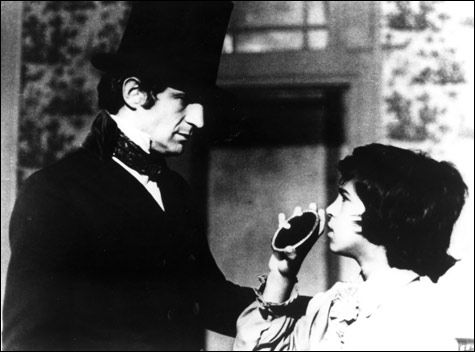
THE WILD CHILD: What keeps the film from getting mushy is Truffaut’s Dr. Itard, who’s kindly without ever being touchy-feely affectionate. |
The Wild Child | Directed by François Truffaut | Written by Truffaut, from the book by Jean-Marc-Gaspard Itard | With Truffaut, Jean-Pierre Cargol, and Françoise Seigner | Film Desk | French | B&W | 83 minutes Review: The Class. By Gerald Peary. |
Like others who toil in the classroom (I’m a long-time film-studies professor at Suffolk University), I constantly fret over whether all those semesters of teacher talk have made a bona fide dent in students’ lives. Thousands in my charge have graduated to the real world, but did I inspire them with my passion for cinema? Do they watch more classic movies, independent and foreign-language works, difficult art films, because of the exposure to such in my classroom?On a bad day, I doubt it all: my ex-students have reverted to mainstream Americana. They’ve forgotten Kurosawa and Bergman. They’re blissed-out at the multiplex. Maybe that’s why I’m such a sentimental sucker for movies that see the classroom as a transformative, magical place where determined teachers make their mark and those in their tutelage are better and wiser for having sat at their desks. Recall earnest Jon Voight and his motivated black pupils on a South Carolina island in Conrack (1974). And in To Sir, with Love (1967), Sidney Poitier’s caring teacher in East End London taking his rowdy blue-collar kids on a class trip to the city’s great art museums.
I can abide even that drippy old pedant lecturing to æons of prep lads in the Hollywood fossil Goodbye, Mr. Chips (1939). Recently, we’ve been blessed with Nicolas Philibert’s tender 1992 documentary, To Be and To Have [Être et Avoir], which shows a real-life teacher doing wonders in a one-room classroom in rural France.
I don’t endorse every celluloid classroom movie. The most popular of them all, The Dead Poets Society (1989), is downright embarrassing. That’s not exemplary teaching that Robin Williams does, just the opposite. He showboats by climbing on desks. He bullies his worshipping students, in the name of non-conformity, into believing what he believes. Fie on his fascistic methods!
But forget Dead Poets — two sublime French movies about the teaching experience are very much alive this week at the Kendall Square. There’s a must-see 35mm revival of François Truffaut’s 1970 classic, The Wild Child [L’enfant sauvage]. And there’s the much-honored nominee for Best Foreign Film at the upcoming Oscars, Laurent Cantet’s The Class [Entre les murs].
Was there ever a more persistently autobiographical filmmaker than François Truffaut, who died at age 52, from a brain tumor, in 1984? His celebrated series of Antoine Doinel films, from The 400 Blows (1959) to Love on the Run (1979), are fictionalized stops at stations of his own dramatic life, with Jean-Pierre Léaud’s Doinel standing in for Truffaut. The Wild Child, which is dedicated to Léaud, has Truffaut’s markings everywhere. He cast himself as the benevolent doctor, Jean-Marc-Gaspard Itard, who takes in the Wild Child, a screeching, filthy human animal found in the woods. In part, Truffaut conceived his Itard as an homage to his mentor, the legendary film critic André Bazin. In the early 1950s, Bazin allowed into his flat an unhappy, undisciplined Parisian child and encouraged the boy’s passion for moviegoing and heavy books. That semi-civilized boy, ignored by his own feuding parents, was François. He was a love-starved auto-didact feasting on Balzac and American genre movies. What Flaubert said of Madame Bovary, Truffaut could assert of The Wild Child: “C’est moi!”
Truffaut’s film is based on long-ago events. A “Wild Boy” was captured in 1798 in the French countryside and brought into Paris to be ogled. Was this smelly, howling being “the noble savage” that Jean-Jacques Rousseau had rhapsodized about? Dr. Itard rescued him from the urban mob and took the Wild Boy to his country estate to befriend him. But far more important for Itard was to study him and to civilize him. The Wild Boy, who was given the name Victor, would be less wild with Itard’s determined guidance. Soundly rejecting Rousseau, Itard would prove that rigorous education elevated humankind instead of corrupting us. The Wild Boy would ascend the chain of being if he could be taught to see and to hear instead of sniffing at the world, if he could sit at a table and eat with silverware. Victor had to be taught to speak, to read, to obey. Ultimately, he was to learn morality, a sense of justice.
A truly remarkable man, Itard published a simple-to-read 50-page tract, The Wild Boy of Aveyron, that’s a potent declaration of humanism at a historic time when charity barely was invented — it’s an amazing text! Truffaut’s movie stays close, in fact and spirit, to its source. The year 1798 is translated visually in black and white by Truffaut’s great cinematographer, Nestor Almendros, and shot in a classic style reminiscent of silent cinema. Most prominent, both for transitions and to frame the culture-shocked Wild Boy, is the free use of archaic “iris in” and “iris out,” a prevalent device in cinema through the 1920s. The extreme long shots of D.W. Griffith seem a source of visual inspiration. The tough-love dynamic between Itard and Victor must have been inspired by Arthur Penn’s The Miracle Worker (1962), by Annie Sullivan’s tug-of-war efforts to educate the obstinate, seemingly deaf-and-dumb Helen Keller.